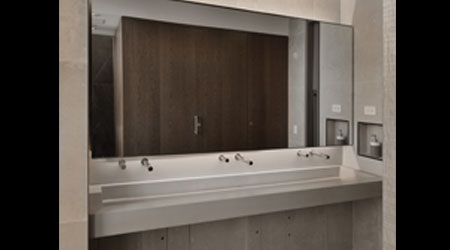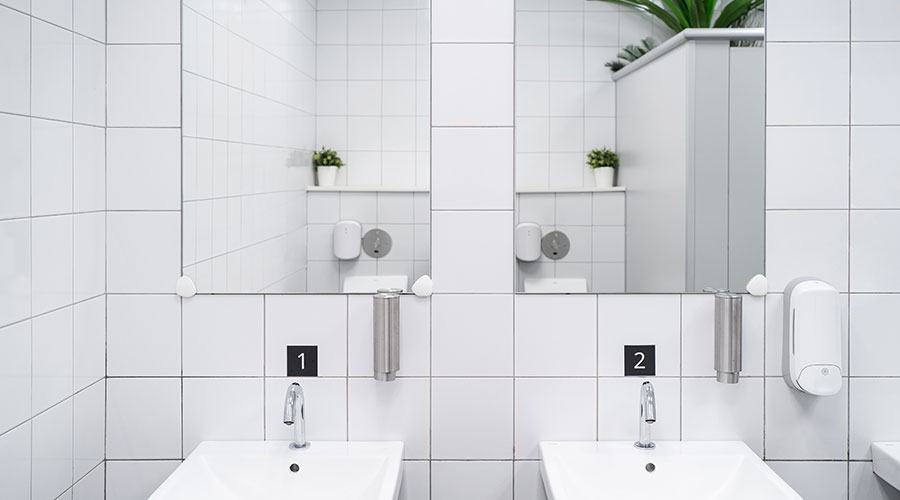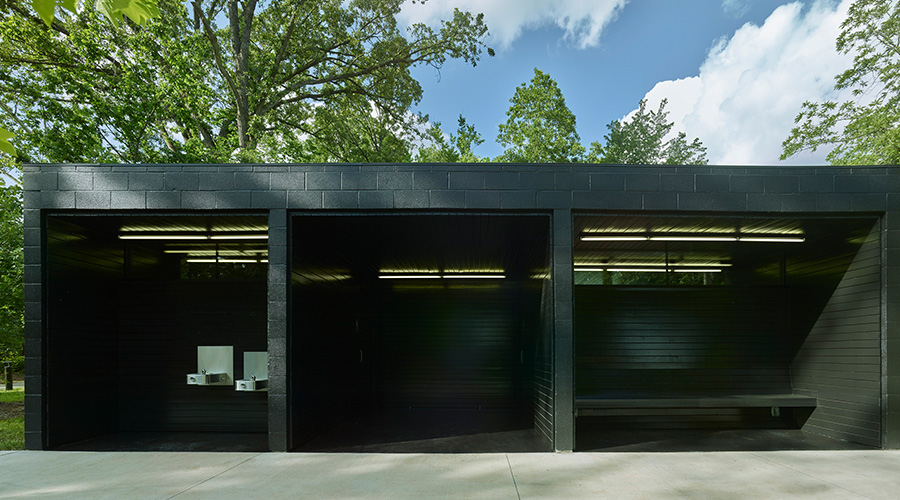 Automated technologies are easy to retrofit into a current space, offering quick and easy hands-free alternatives to improve hygiene and minimize the number of surfaces people come into contact with.Ted Moudis Associates
Automated technologies are easy to retrofit into a current space, offering quick and easy hands-free alternatives to improve hygiene and minimize the number of surfaces people come into contact with.Ted Moudis AssociatesCoronavirus Has Made Touchless Restrooms a Must
No longer a nice-to-have, touchless restroom fixtures should be retrofitted into commercial restrooms.
As more commercial and institutional spaces begin to reopen around the country, health experts have repeatedly warned of the potential dangers of sharing close quarters with others, which has encouraged renewed questions regarding the safety of public restrooms. Commercial restrooms have often been approached from a strictly utilitarian perspective, starkly designed and commonly lacking the space required to develop the programming necessary for privacy, cleanliness, and comfort –– not to mention, the complexities associated with gendered restrooms, which have long been the subject of debate. Facility managers now face the daunting task of keeping these restrooms clean and safe through short-term and long-term changes to their design and maintenance.
Convenience and durability were once the two most important considerations in restroom design, according to Patrick Ventker, team principal, and Rachel Robinson, design director, of Ted Moudis Associates, an architectural interiors firm headquartered in New York City.
“Now, user health and wellbeing have become equally important, touching as few surfaces as possible and ensuring the ability to deep clean those surfaces,” Robinson says.
Making the commercial restroom touch-free experience is a must for public health and safety to help reduce the risk of spreading the virus, and facility managers should certainly reconsider their current selections. Moreover, that demand for a touchless experience will fundamentally alter the way materials are chosen for commercial restrooms. As such, solutions that require little or no contact should take priority when re-evaluating the way a restroom is outfitted in the pre-vaccine world.
“The key is to try to make your restroom as touch-free as you can within your budget,” says David Tracz, co-founder and principal of architecture and design firm //3877. “However, be smart about it, and make sure you have a regular maintenance process in place to ensure all touchless fixtures and motion sensors are in good working condition.”
Automated technologies are easy to retrofit into a current space, offering quick and easy hands-free alternatives to improve hygiene and minimize the number of surfaces people come into contact with. For example, some facility managers are adding motion-sensored paper towel dispensers, placed near the doors, if possible. Facility managers can go the extra mile by placing waste bins and hand-sanitizer stations outside restroom doors to allow people to toss paper towels used to exit or to quickly disinfect after touching the door pull.
“This was a good practice pre-COVID, but we envision that it will become more standard moving forward,” Ventker says.
Hands-free hardware such as foot pedals or hip pulls have increased in popularity in recent months to address those concerns associated with restroom entry and exit, but Tracz cautions against the widespread use of these alternatives.
“While adding a foot-operated door pull may seem like a good solution at first — largely due to its affordability and easy installation process — you have to think about what behavior you’re encouraging and what other potential problems you might unintentionally cause,” he says. “A foot pedal requires that people balance on one foot, so ultimately you’re creating a potentially awkward or dangerous situation, especially if someone suddenly enters or exits and knocks you off balance.”
Instead, Tracz and his business partner, David Shove-Brown, recommend focusing on hands-free soap, water, and flushing capabilities for existing facilities that managers are looking to simply retrofit. They are also seeing increased demand for self-contained basins, where handwashing and drying functions are wrapped into one fixture to minimize movement within cramped restrooms. And for any door knobs left behind? Robinson recommends applying a self-cleaning wrap to handles.
Changes to touch surfaces
"You can reorganize a workspace or a restaurant for social distancing with a bit more strategy, but areas of natural congregation such as restrooms will need to be reconfigured," Shove-Brown says, noting that the designer's biggest challenge in the short term is redefining the word safe in terms of cleanliness. Materiality goes a long way in helping to achieve this message, and facility managers should consider taking cues from healthcare design to create a cleaner appearance.
“Commercial clients have begun to embrace hospitality design, even in their restrooms, but the aesthetic of these spaces should always follow function,” Ventker says. “For now, that means prioritizing durable, hard-top surfaces that are easily bleachable.”
Hard surfaces are not only easier to wipe down at regular intervals, but they create a more optimal situation for UV-C disinfection –– a lighting technology that is beginning to receive more attention among facility managers whose departments don’t quite have the capacity to clean each bathroom in the building on the hour. Ventker and Robinson also recommend ceiling-integrated air purification and upgraded filtration systems if the budget allows because they create a vacuum that draws out viral aerosols between regular cleanings. Porcelain and ceramic tiles are ideal, as they are both slip-resistant and will hold up to wear and tear. Polished surfaces that reflect too much light are usually unsuccessful in restroom environments.
Shove-Brown, Ventker, and Robinson agree that large-format porcelain tiles or concrete are the best materials for bathroom flooring. While nothing is truly COVID-resistant, it’s important to select surface materials that are easily cleanable with very limited joints and separations.
“Limiting grout lines and generally using a medium tone flooring selection also help with the maintenance of the flooring,” Shove-Brown says. “For example, we had a fitness center project where we used a vinyl material that comes on a roll that becomes the wall base and is installed as one piece without seams, which helps with the spread of germs and cleaning. Epoxy flooring also has some great potential since it’s a spray-on flooring used for everything from fitness centers to commercial kitchen floors to auto garages. It is durable, easy to clean, can follow the slope of the ground to floor drains, and provides a way to add color if desired. Durability and cleanability are fundamental considerations we take into account as designers when selecting restroom materials.”
Related Topics:













